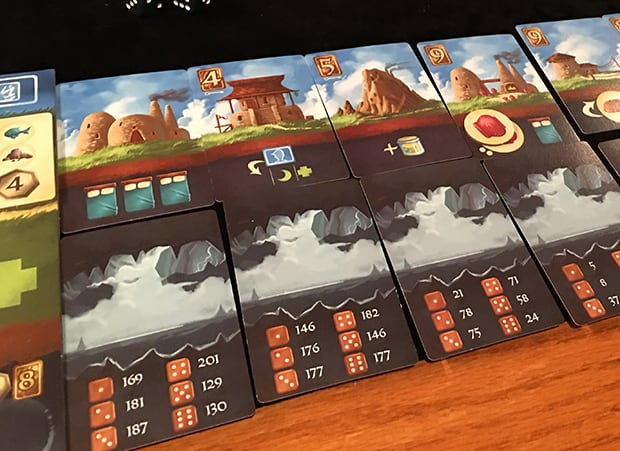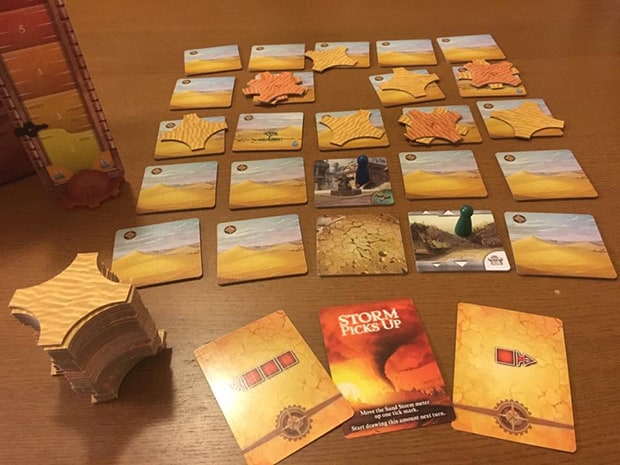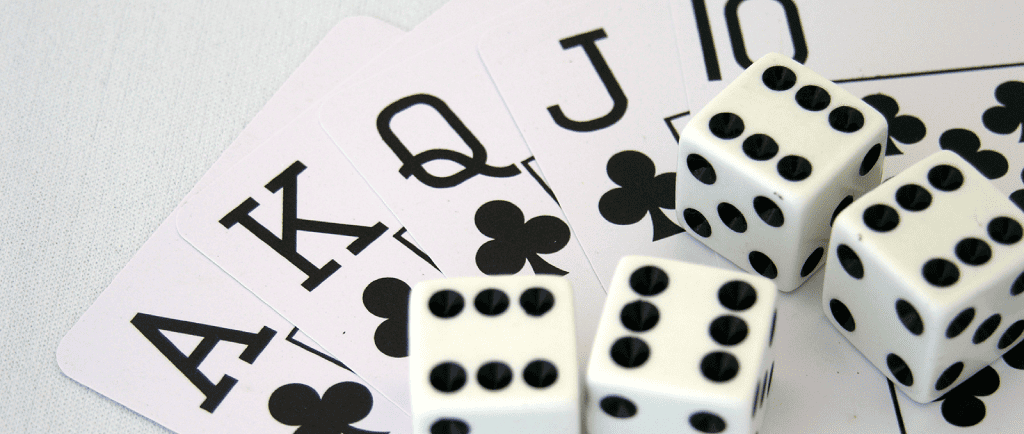
Wish it was Sunday…
What tabletop games did you play over the weekend? Do you do as I do and think on what makes a board game tick? If you like it, what mechanisms made it successful? If you didn’t like it, there may even still be a piece of the game design you appreciate.
—

Somebody should build some buildings in those caves!
ABOVE AND BELOW – OPTIONAL RISK/REWARD
Above and Below has become a popular choice at my game nights, not only because of the charming art and design, but because of the mashup of a resource gathering game and a storytelling game. There’s an interesting thing that designer Ryan Laukat has done here – he’s added this entire bonus game that you don’t have to play to win. So in the game, you allocate workers, and you can allocate 2 or more to go exploring. The person to the player’s left reads a story which may result in spoils. If you succeed even in the slightest, you get a cave card, which allows you to build underground buildings (which are generally cheaper). While the adventure itself is a gamble, often getting the card isn’t difficult, so I think this encourages all players to give it a try even if it’s not their main strategy. For the most adventurous players and gamblers, of course – it can be a key way to to achieve victory.
CASTLE OF MAD KING LUDWIG – MASTER BUILDER, I PICK YOU CHOOSE
I love Suburbia from Bezier Games, and I was sold on Castles of Mad King Ludwig even if it had been just adding a funky new building theme – but the games are unique. One similarity is a tableau of tiles to buy. Granted, the Suburbia method of tiles entering play, cycling in with some fresh selection options for the players could be on this list in it’s own right, but something special happens in Castles. The active player, called the Master Builder, takes all the tiles up for auction, and is allowed to rearrange them as they see fit, at the various prices. All the other players then get first dibs, but must pay the money to the active player. Because they go last, the active player may get some income for their turn by the other player actions. So they have incentive to affordably price the structures that they know the other players want. It’s magical, and I can’t imagine this castle game without it.

FORBIDDEN DESERT – THEMATIC CONSONANCE, LEVELS OF DEPTH
Leaguer Scott Caputo chimes in with a great description of this mechanic: “The Forbidden Desert board consists of 24 tiles in a 5×5 grid with one empty spot that is the “eye” of the storm. After every player’s turn, a number of storm cards are drawn which shift the eye over 1 to 3 times in a certain direction. For each tile shifted, it is covered with a piece of sand. If a tile is covered with two pieces of sand, it is considered impassable. At the most basic level, the storm mechanic adds the challenge to the game, suddenly dumping sand on tiles you really need to excavate. If you run out of sand tiles, you and your group lose.
At a more subtle level, the storm is actually rearranging the tiles. A tile in one row may actually get moved to another row, and then later to another row. One could imagine that in a sand storm, you might get so disoriented that the entire world seems to get rearranged. Another nice thing about the mechanic is that it has built-in “near misses”. Once the eye of the storm gets stuck in a corner of the grid, many of the storm cards will have no effect, so you and your team get a much needed breather. Overall, drawing a number random cards may seem overly random, but you and your team can see where the eye of the storm is and have a pretty good idea where the eye might go next turn, adding another layer of strategy for smart players. Finally, much like Pandemic’s increasing infection rate, the number of storm cards to draw after each player’s turn increases over the course of the game, ramping up the excitement just as you and your team are about to escape on the fabulous flight machine.”
T.I.M.E STORIES – QUANTUM LEAP
Ok, I probably would have bought T.I.M.E Stories if it wasn’t in a clean white gorgeous box, promising hours of storytelling and wrapped in a time travel theme, but I think the fact that it employs a groundhog day/quantum leap style mechanic where you get information that helps you each successive mission is a fascinating one to study. Having played a few of the scenarios now, and seeing them get better and better, I think it’s safe to say now that this game, along with recent legacy titles, are opening up designer’s minds to what is possible in board game play experiences. Breaking up the game into bite size pieces with the clock, while simultaneously driving the puzzle by player discovery, this mechanic is gripping and interesting, and doles out the adventure at a proper pacing.
PANDEMIC LEGACY SEASON 1 – NEW RULES MID GAME
Jeff Cornelius suggested Pandemic Legacy for this list, and I couldn’t agree more that it has mechanisms that are worthy of any top list. Kudos to Rob Daviau and Matt Leacock (who is now making today’s list twice) for this strong design. Without giving anything away at all, I can tell you that the discovery of closed boxes over time and the secret cards and folders are all very satisfying. One of my takeaways of this is in the rulebook, which shows you places where rule stickers will go. This does a few things – it creates anticipation for what is to come, and shows volume and scope of the changes, while simultaneously giving you the rules in bite size chunks that you can digest before new parts are added. This interactivity is great. Many more games should have a “do not open until you’ve played X times” section of the rules so that you know when to appreciate it!

—
Part 1 of Mechanic Monday is here, where we looked at cool mechanisms in Five Tribes, Pandemic (the original), Bang!, King of Tokyo, Imperial Settlers, and Puerto Rico.
WHAT GAME MECHANICS DO YOU ENJOY?
Share the title and why. And thanks for playing!







